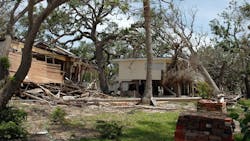States Where Home Insurance Costs Hinder Affordability
Home insurance is becoming increasingly expensive in the U.S. due to rising rebuilding costs and more frequent extreme weather events. On average, households now pay about $2,470 per year for insurance, which equates to 3.2% of the median household income. Since 2023, premiums have risen 9% nationally, adding roughly $209 to the average payment over the past two years.
While the nationwide average sits at just over 3%, payments vary greatly by state. To assess home insurance affordability across the U.S., financial services company Bankrate compared the average cost of a $300,000 home insurance policy in each state and metro area with their local median incomes.
In high-risk states with lower household incomes, insurance price growth has had the greatest impact on housing affordability
The top three states that spend the most on home insurance are Louisiana, Nebraska, and Florida—all of which have extreme weather that poses a challenge to home insurance companies and to homeowners seeking coverage.
With the average household income in Louisiana at $58,229 per year and an average annual insurance cost of $6,274, homeowners there spend 10.8% of their income on home insurance, the highest rate in the report.
Likewise, homeowners in Nebraska have an average household income of $74,590 and average insurance costs of $6,425 per year, meaning that they spend 8.6% of their income on insurance.
With a median household income of $73,311 and an average insurance rate of $5,735 per year, Floridians spend 7.8% of their annual income on home insurance.
In some metros, insurance costs are high, but wage growth makes them seem less substantial
In some regions, however, higher household incomes help offset steep home insurance costs. For example, in the Denver area, premiums average $3,644 per year—well above the national average—but with a median income of $103,055, homeowners in this metro spend only 3.5% of their earnings on insurance coverage.
A similar trend appears in the Los Angeles and San Diego metros. Because of high incomes in these markets, homeowners spend less than 3% of their income on home insurance.
Where have insurance rates increased the most?
California has seen the sharpest jump in home insurance costs, with average policy prices climbing 41% from 2023 to 2025, while the median income statewide grew by only 12.5%.
A similar imbalance exists in Michigan. From 2023 to 2025, median household income rose by less than 9%, but the average cost of home insurance surged 29%, jumping from $1,819 to $2,351.
How have insurance costs grown over time?
- Home Insurance Costs Surge: In the past two years, home insurance costs grew by 9%, and from 2020 to 2023, they grew by an additional 33%.
- Amid High Housing Costs, Home Insurance Rates Continue to Rise: Data show that insurance costs continue to rise year-over-year, with even traditionally low-risk Midwestern states now being impacted.
